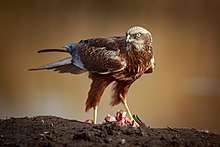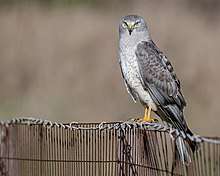Harrier (bird)
A harrier is any of the several species of diurnal hawks sometimes placed in the subfamily Circinae of the bird of prey family Accipitridae. Harriers characteristically hunt by flying low over open ground, feeding on small mammals, reptiles, or birds. The young of the species are sometimes referred to as ring-tail harriers. They are distinctive with long wings, a long narrow tail, the slow and low flight over grasslands and skull peculiarities. The harriers are thought to have diversified with the expansion of grasslands and the emergence of C4 grasses about 6 to 8 million years ago during the Late Miocene and Pliocene.[1]
| Harriers | |
|---|---|
 | |
| western marsh harrier | |
| Scientific classification | |
| Kingdom: | Animalia |
| Phylum: | Chordata |
| Class: | Aves |
| Order: | Accipitriformes |
| Family: | Accipitridae |
| Subfamily: | Circinae |
| Genera | |
|
Circus | |
Etymology

The genus Circus was introduced by the French naturalist Bernard Germain de Lacépède in 1799.[2][3] Most harriers are placed in this genus. The word Circus is derived from the Ancient Greek kirkos, referring to a bird of prey named for its circling flight (kirkos, "circle"), probably the hen harrier.[4] The name harrier is thought to have been derived either from Harrier (dog), or by a corruption of harrower, or directly from harry.[5]
Ring-tails
Ring-tail is an informal term used by birders for the juveniles and females of several harrier species when seen in the field and not identifiable to an exact species. Ring-tail harriers include the juveniles and females of Montagu's harrier (Circus pygargus), hen harrier (Circus cyaneus), and pallid harrier (Circus macrourus).
Species
- Genus Circus
- Montagu's harrier, Circus pygargus – Eurasia, winters in Africa and India
- Hen harrier, Circus cyaneus – Eurasia
- Northern harrier, Circus hudsonius – North America[6]
- Western marsh harrier, Circus aeruginosus – Europe, western Asia; winter range includes Africa and India.
- Eastern marsh harrier, Circus spilonotus – Asia (migratory)
- African marsh harrier, Circus ranivorus – southern and central Africa
- Swamp harrier, Circus approximans – New Zealand, Australia, Pacific islands
- Papuan harrier, Circus spilothorax – New Guinea (formerly treated as a subspecies of C. spilonotus, then C. approximans, but now considered distinct)
- Malagasy harrier, Circus macrosceles (formerly in C. maillardi) – Indian Ocean (Madagascar and the Comoro Islands)
- Réunion harrier, Circus maillardi – (Indian Ocean) Réunion Island
- Long-winged harrier, Circus buffoni – South America
- Spotted harrier, Circus assimilis – Australia, Indonesia
- Black harrier, Circus maurus – southern Africa
- Cinereous harrier, Circus cinereus – South America
- Pallid harrier, Circus macrourus – migratory: eastern Europe, Asia, Africa (winter)
- Pied harrier, Circus melanoleucos – Asia
- † Eyles's harrier, Circus eylesi (prehistoric)
- † Wood harrier, Circus dossenus (prehistoric)
The subfamily Circinae has traditionally included the genera Polyboroides and Geranospiza which include three species - the Madagascan harrier-hawk, (Polyboroides radiatus), the African harrier-hawk, (Polyboroides typus) and the crane hawk, (Geranospiza caerulescens). This may however not be a valid subfamily as the monophyletic genus Circus is nested within the Accipiter groups while the other two genera are non-monophyletic and are part of the larger Buteonine clade. Many species in the genus Circus show very low diversity in their mitochondrial DNA due perhaps due to extreme drops in their populations. They are prone to fluctuations with varying prey densities.[7][8]
Notes
- Oatley, Graeme; Simmons, Robert E.; Fuchs, Jérôme (2015). "A molecular phylogeny of the harriers (Circus, Accipitridae) indicate the role of long distance dispersal and migration in diversification". Molecular Phylogenetics and Evolution. 85: 150–60. doi:10.1016/j.ympev.2015.01.013. PMID 25701771.
- Lacépède, Bernard Germain de (1799). "Tableau des sous-classes, divisions, sous-division, ordres et genres des oiseux". Discours d'ouverture et de clôture du cours d'histoire naturelle (in French). Paris: Plassan. p. 4. Page numbering starts at one for each of the three sections.
- Mayr, Ernst; Cottrell, G. William, eds. (1979). Check-list of Birds of the World. Volume 1 (2nd ed.). Cambridge, Massachusetts: Museum of Comparative Zoology. p. 316.
- Jobling, James A. (2010). The Helm Dictionary of Scientific Bird Names. London: Christopher Helm. p. 109. ISBN 978-1-4081-2501-4.
- Hogg, John (1845). "A catalogue of birds observed in South-eastern Durham and in North-western Cleveland". The Zoologist. 3: 1049–1063.
- Etherington, Graham J.; Mobley, Jason A. (2016). "Molecular phylogeny, morphology and life-history comparisons within Circus cyaneus reveal the presence of two distinct evolutionary lineages". Avian Research. 7. doi:10.1186/s40657-016-0052-3.
- Griffiths, Carole S.; Barrowclough, George F.; Groth, Jeff G.; Mertz, Lisa A. (2007). "Phylogeny, diversity, and classification of the Accipitridae based on DNA sequences of the RAG-1 exon". Journal of Avian Biology. 38 (5): 587–602. doi:10.1111/j.2007.0908-8857.03971.x.
- Fuchs, Jérôme; Simmons, Robert E.; Mindell, David P.; Bowie, Rauri C. K.; Oatley, Graeme (2014). "Lack of mtDNA genetic diversity in the Black Harrier Circus maurus, a Southern African endemic". Ibis. 156: 227–230. doi:10.1111/ibi.12103.
External links
| Wikimedia Commons has media related to Circus (genus). |
- Harrier videos on the Internet Bird Collection
- Harrier videos on the Internet Bird Collection
- Newton, Alfred (1911). . Encyclopædia Britannica. 13 (11th ed.). p. 17.